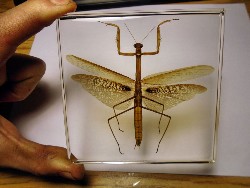
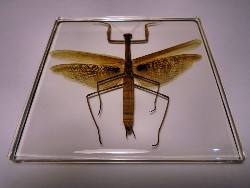
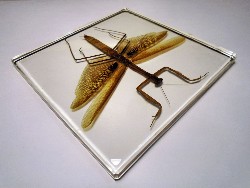
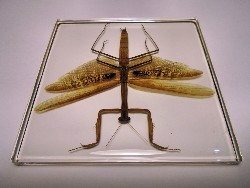
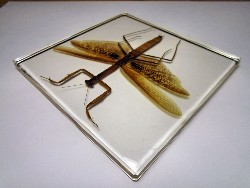
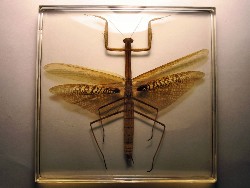
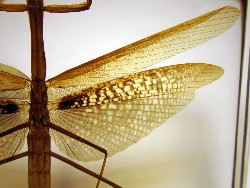

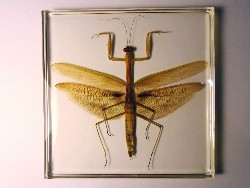
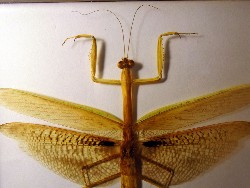

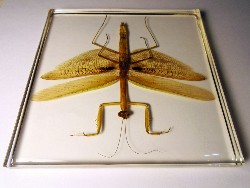
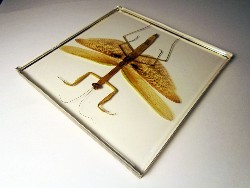



 |
 |
 |
 |
 |
 |
 |
 |
 |
 |
 |
 |
 |
 |
 |
 |
|
The genus Metallyticus reviewed (Insecta: Mantodea)  CLICK FOR DOWNLOAD .PDF --------------------------------- Classification Phylum: Arthropoda Class: Insecta Order: Mantodea Family: Mantidae Subfamily: Mantinae Tribe: Polyspilotini Genus: Tenodera Species: Tenodera aridifolia
.............................. Phylogenetic systems ofMantodea (Dictyoptera)
CLICK FOR DOWNLOAD .PDF |
Tenodera aridifolia What do they look like? Chinese mantids are about 7 cm long and weigh about 3 grams. They have a tan, brown, or sometimes pale green cuticle, and the edge of the forewings forms a green stripe on the side of the body. The head is triangular and can swivel a full 180 degrees, and they have very large eyes. Just like in all other mantis species, the first pair of legs is modified into a folded pair of arms that are used to grab prey. Male and female Chinese mantids are noticeably different. On average, females are 10 cm long (or even longer), which is about 2 cm longer than the males. Where do they live? Chinese mantids (Tenodera aridifolia) are native to Asia, specifically Japan, India, and Indonesia. The species was introduced to the United States by humans in the late 1800s and now is common throughout the United States, especially the eastern United States and California. Today, Chinese mantids can be found throughout most of Asia. They also have been introduced into Australia. They are common throughout the Oriental and Nearctic regions. What kind of habitat do they need? Chinese mantids are the most widespread and abundant mantis species in temperate zones. This species usually is found in grasslands, meadows, agricultural fields, woodlands, and near rivers and streams. It is common in humid habitats. Chinese mantids inhabit a broad range of land in various stages of ecological succession, most commonly in old-field ecosystems. They spend most of their time on herbaceous plants and woody shrubs and also can be found near flowers. How do they grow? Like all mantises, Chinese mantids are hemimetabolous insects, which means that they develop by incomplete metamorphosis. Incomplete metamorphosis is a life cycle that begins with an egg, which hatches into the larval form , and then develops into an adult. Incomplete metamorphosis skips the pupal stage, which is the difference between incomplete and complete metamorphosis. Chinese mantid eggs are laid on plants in a protective egg case called an ootheca. The ootheca is laid as a frothy material, which hardens to form a protective case around the eggs. The eggs begin to develop immediately after being laid within the ootheca, until the cold weather triggers dormancy (hibernation). The eggs overwinter until temperatures become warmer. Excluding the overwintering time, eggs hatch after about 6 weeks of development in early spring. Nymphs grow through as many as 7 instars before developing wings and becoming adults in late summer. Adults reproduce and survive until the first frost. How do they reproduce? Male Chinese mantids mate repeatedly and fertilize multiple females when possible. Females also mate with multiple males, but they usually lay only one egg case, and the different eggs within a single ootheca may have different fathers. Only male Chinese mantids fly, so the males actively seek mates. Males detect and follow long-distance pheromones from up to 100 m away. To attract males, a female flexes her abdomen, which exposes the pheromone glands on her abdomen. These glands secrete chemical signals that can be used to communicate with other individuals. Males are more attracted to virgin females, which suggests that females decrease their pheromone production and other behaviors after their first mating event. Males perform courtship behaviors such as pumping their abdomens up and down and wiggling from side to side. They approach females directly from the front or from behind. Females also may approach and actively participate in courtship, showing such behaviors as stroking the forelimbs of the male. Chinese mantids are sexual cannibals--the female eats the male during or after copulation, often beheading him. Cannibalism benefits the female because she can obtain food by eating her mate. When prey is scarce and females are hungrier, they are more likely to cannibalize their mate. Hungrier females will even make predatory strikes toward males before copulation begins. The potential threat of cannibalism probably explains why males show more cautious behaviors and move much more slowly when they approach females from the front, in contrast to when they approach females from behind. These differences in courtship behaviors, which vary with the amount of risk involved, may be triggered by female pheromones or behavioral signals. Sexual cannibalism may provide some benefits to the male, as well. Males can continue copulating after they have been beheaded, although they cannot mount new females on their own. Cannibalism may result in a longer copulation event, allowing the male to transfer more sperm to the female and possibly preventing other males from mating with her. Chinese mantids begin mating 8 to 10 days after their final molt, in the late summer or early fall. They can continue breeding until they die during the first frost, usually in the late fall. In general, Chinese mantids are univoltine, which means that one new generation appears and develops each year. The species generally is semelparous, which means that a female lays eggs only once in her lifetime. Female Chinese mantids usually lay only one egg case, but the mantids at lower latitudes (where the climate is warmer and the breeding season is longer) can produce multiple oothecae if the temperatures are high enough later in the year. A single ootheca contains 50 to several hundred eggs. If a female produces multiple oothecae, she can lay about 600 eggs during the breeding season. Females produce smaller egg cases when prey are scarce, but the mantis species that cannibalize their mates lay larger oothecae and produce more offspring. Oothecae can weigh up to 1.5 g, which represents half the weight of a female. The significant weight of an ootheca indicates that females invest a large amount of resources in their offspring. Eggs overwinter and hatch the following spring. More males usually are born than females, but because of sexual cannibalism, adult Chinese mantid females are more common than males. Parental care in Chinese mantids is limited to the female creating the protective ootheca (egg case), which allows the eggs to develop safely until they hatch. Females invest a significant amount of energy carrying the eggs and creating the ootheca. They lay the eggs on plants in locations where conditions will prevent the eggs from drying out. After the eggs are laid, the adults provide no more care or protection. Males either leave or are killed after mating and provide no care. Adult Chinese mantids die when the first frost occurs, so they cannot provide any parental care for the nymphs that will hatch the following spring. How do they communicate with each other? Like all mantises, Chinese mantids have excellent vision. They detect other Chinese mantids and prey visually. A Chinese mantid easily can keep track of moving objects due to its large eyes and the mobility of its head. Adult females secrete pheromones that are detected by males looking for mates. Males probably detect pheromones using receptors on their antennae. Some tactile communication has been observed between males and females during courtship, such as the female stroking the forelimbs of the male. Nymphs also have been observed using their antennae to detect pollen grains, probably through a combination of tactile and chemical sensing. Adults can detect prey by olfaction . How do they interact with us? Chinese mantids were introduced to the United States by humans in 1896 as a form of pest control. Today, they still can be purchased to reduce pest populations in gardens or agricultural fields. They also can be kept as pets, because they are mostly harmless to humans and are very easy to care for. They can be kept in a medium- to large-sized aquarium and need to be fed live insects every other day or so. Egg cases can be purchased in pet or gardening stores.
|